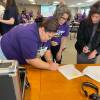On a recent afternoon in Lexington, Aloke Roy and his parents watched as a dancer, adorned with gold jewelry, performed bharatanatyam, a classical South Indian dance. Aloke, 23, likes to attend these shows any chance he can, where he is captivated by the bright colors and storytelling through dance.
Aloke has severe autism and several developmental disabilities. His mom, Mona, says experiences like the bharatanatyam performance are important for him because he has regressed in the past year. Since he turned 22 and aged out of his school, he has lived in a group home nearby in Burlington. His mom says he lost progress he made and has developed challenging new behaviors.
“He desperately needed school,” she said. “And now he just doesn’t have it.”
In Massachusetts, young people with autism rely on their public school district for academics, vocational training, job readiness and life skills training. But after they turn 22, school support ends, and those who need high levels of support start to rely on state services. Advocates say there aren’t enough workers for the state’s group homes and day programs, and as a result, the system is failing young adults like Aloke. That puts a major strain on families and caregivers, who are faced with long waits for fewer options. Some decide the best approach is to fill the gap themselves, quitting jobs to stay home or paying out of pocket for service workers.
“Aloke’s story is emblematic of so many kids, where they don’t get the support they need to be able to function in the real world,” Mona said. “He fell off a cliff.”
A systemic failure
Maura Sullivan, recently named CEO of The Arc of Massachusetts, knows the challenge well, both as an advocate and a parent: She has two sons with autism, one of whom just aged out of school.
“When they turn 22, the school system funding goes away. And that’s why we often refer to this as ‘the cliff,’ where you step off into funding that’s really based on the adult services safety net,” Sullivan said.
Families start to rely on a combination of services through Department of Developmental Services, MassHealth and other agencies — funded each year by the state budget.
Sullivan says state leaders have been supportive in recent years but the real problem now is the workforce shortage. Advocates say that following the pandemic, the low pay for human service workers has led to staff leaving for higher-paying jobs in other fields, leaving thousands of adults with autism and other developmental disabilities without the help they need every day. Day programs, located in towns throughout the state, provide adults with individualized daily support as well as activities and training on independent living skills and, if needed, behavioral therapy.
The number of young adults needing services has increased, Sullivan says. She estimates that in the coming year about 1,500 students with severe autism and intellectual or developmental disabilities will leave the school system and seek adult services through the state. Just a decade ago, that number was around 700.
The state is working to address the worker challenge. They have invested in care programs, increased pay rates — up to around $20 an hour from $16 — and set up outreach programs to recruit more workers. But advocates like Sullivan say it’s still not enough to recruit and retain workers as the cost of living increases.
Families face an ‘abrupt’ transition
Before he turned 22, Aloke was enrolled in a residential program at the May Institute in Randolph, a school for students with intellectual and developmental disabilities, where he was thriving, working on academic goals in social studies and math. He also had a job assembling packets for an insurance company. But it was far from the family’s home in Lexington — about an hour drive each way — and difficult to get to during the pandemic.
Aloke turned 22 last February and left school, so they needed to find a group home for him to live in and a day program to replace school. They found a group home in nearby Burlington, where he lives with other adults who have intellectual and developmental disabilities and has staff support 24/7. But his family couldn’t find a day program until June. To bridge the gap, his mom stopped working and his family hired private workers. But it was unsustainable.
Now, staff bring him from the group home to the day program in Watertown. It’s at least a safe place for Aloke to go each day, but Mona wishes her son could receive more attention there. She says in school, the student-to-staff ratio was 2-to-1 or even 1-to-1. At the Watertown day program, it’s around 6-to-1. She describes Aloke’s day-to-day life as “lusterless,” lacking stimulation and enriching activities. It’s been hard to get him important behavioral therapy.
“He sits in a room. He doesn’t have any academic goals anymore,” she said. “He’s regressed so much, I just can’t even believe it.”
Aloke has developed new behavioral challenges, like ripping and chewing his clothes, and taking his seat belt off in the car. His verbal skills have declined. His family is considering medical interventions to address the challenges and have considered putting him on antidepressants.
They had always hoped to take him to Disney World, but now Mona is not sure if they can.
“Despite how much we love him, we worry that if we don’t figure out a way to turn it around, he won’t be able to be part of any more family activities — and that’s really heartbreaking,” she said.
Some families are hesitant to put their adult child in a group home because of fear of neglect, but Mona says the staff at Aloke’s group home is caring and doing their best as they are understaffed.
The family picked the Burlington group home so they could see Aloke more easily than when he lived in Randolph. They also realized that he had grown isolated from his cultural identity. Aloke started to miss Indian food, Bollywood music and Indian dance since he moved into the group home. Now, they are able to pick him up and take him to events like the dance show.
“We realized that the one thing he couldn’t do when he was far away was he couldn’t access his culture and his identity,” she said.
“Despite how much we love him, we worry that if we don’t figure out a way to turn it around, he won’t be able to be part of any more family activities — and that’s really heartbreaking."-Mona Roy
Mona acknowledges that her family is privileged to have insurance and resources to try to navigate the system. Yet it’s still a challenge, and she says it’s difficult to think about a plan for the future.
“I don’t know that I have the physical stamina and the health at this age and stage of my life to manage him,” she said. “I can’t even think too much, because if I do, it’s just soul-crushing to think that we won’t … we don’t even have a good plan.”
A long transition
Even for families with less severe needs who do find services, the transition after 22 can be daunting.
Melrose resident Alaine Breen’s son Ryan was 4 when he was diagnosed with being on the autism spectrum. She remembers the feeling of being “thrown to the wolves” as she started navigating the school system, forcing her to quickly become an expert and advocate. It took some time, but she eventually became “well-versed” at understanding the educational system.
Then Ryan graduated from high school and turned 22. “It took me right back to when he was 4 years old,” she said.
To access adult services, families must submit a referral to the state as early as two years before they turn 22 or finish high school. A DDS transition coordinator works with each family to create a plan. The DDS transition guide encourages families to start planning for the transition at age 14, with the knowledge that services can be understaffed. Some families find one at the last possible minute. While Alaine experienced a relatively smooth transition for Ryan out of Melrose Public Schools, she still found the process jarring.
“It really does become a situation of who do I call? Where do I go? … You’re back to ground zero as far as knowing literally nothing,” she said.
For now, Alaine feels lucky. Ryan is in the two-year Threshold Program at Lesley University, where students with intellectual and developmental disabilities live in dorms, and learn independent living skills like time management and budgeting. Ryan is “thriving.” He hangs out with friends, and joined the college’s golf team. He’s learning how to use the MBTA and hopes to get a job when the program is done.
At home on a recent morning, Ryan checked his email as his mom asked how he feels about the upcoming year.
“I like that program,” he said. “Good, I’m feeling solid.”

Looking to the future
Abby Parrilla, CEO of The Arc of the South Shore, says that housing is another challenge.
“What I have found when speaking with caregivers is there just isn’t enough housing, particularly for this younger population ... that need group home placement with the time, attention, expertise to their unique needs,” said Parrilla.
That’s why they are planning to build a group smart home specifically designed for people in the autism community ages 22 and up. It will open in September 2025 in Braintree. They hope to build more in coming years.
Parrilla hopes that the initiative will help ease parents’ anxieties.
“When parents get to a certain age, you start worrying about, 'OK, when I’m not here, what happens to my child?’ It is a burden on all parents, but it is a major burden on parents with a child with autism or intellectual and developmental disabilities,” she said. “So we get to answer that call for parents, give them that safety and security.”
Back in Lexington, during the dance show intermission Aloke greeted Jayshree Rajamani, the dance teacher who invited him to come to the performance after hearing about his difficult transition. Aloke held her hands and they took a picture together.
She said it’s been a joy to watch Aloke at the performances. It has inspired her plans to one day start a program for adults with disabilities to participate in Indian classical dance.
“If I can make one child of one human happy through my dance, I’m happy to do that.”








